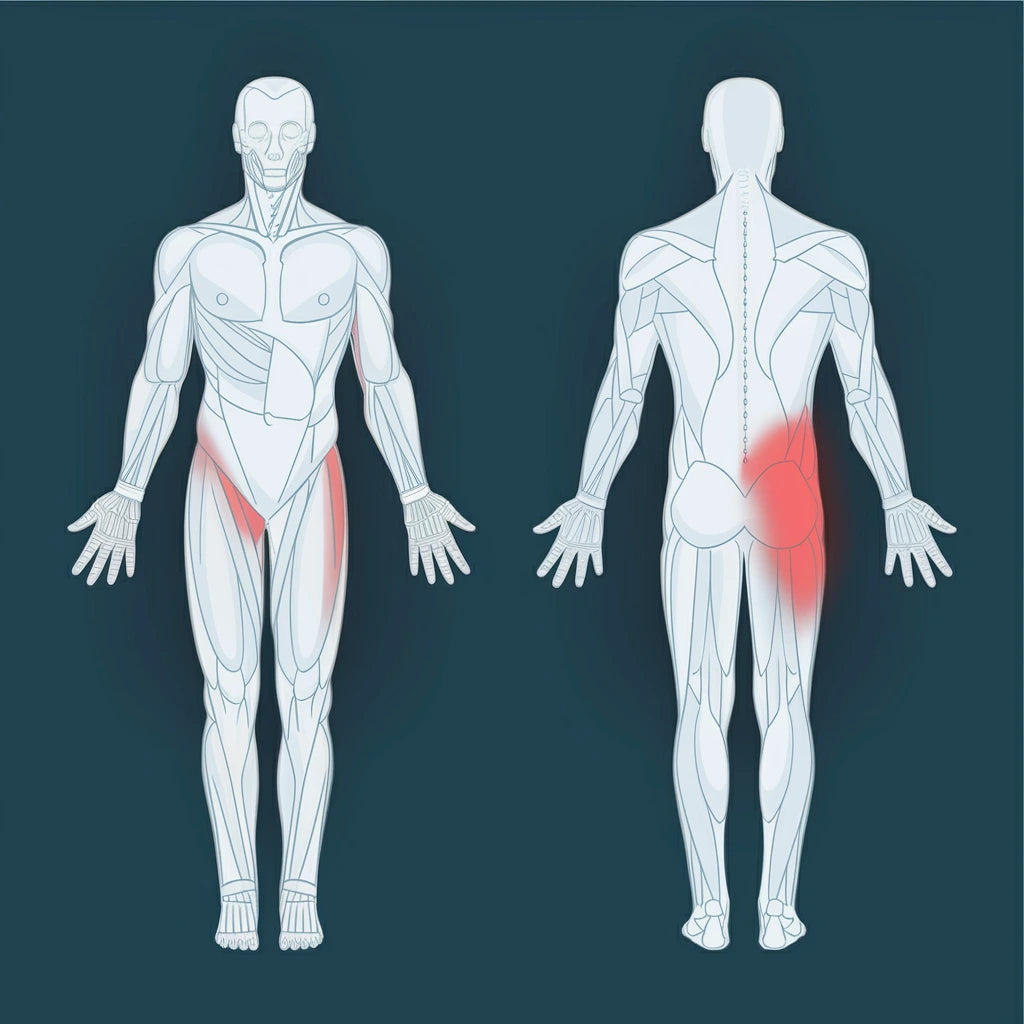Pain in the Groin: Symptoms, Causes, and Treatment

Groin pain is a common issue that can have several different causes. This article discusses the most common symptoms, causes, and treatment options for groin pain.
What Is Groin Pain?
Groin pain can be due to muscle strains, overexertion, or injuries. The pain often occurs during physical activity or sudden stress. Rest, stretching, and appropriate treatment can alleviate discomfort. If the pain persists, you should seek medical attention.
Symptoms of Groin Pain
Common symptoms include:
- Sharp pain in the groin
- Sore or dull ache in the groin area
- Pain that worsens with movement or strain
- Swelling or bulging in the groin
- Pain radiating down the thigh or up towards the abdomen
If you experience groin pain that radiates down your leg, it may indicate nerve involvement. Symptoms can also include stiffness in the hip joint and groin, making it difficult to walk or stand for extended periods. Groin pain when lifting the leg is a common sign of muscle or tendon issues in the area, especially if the pain is felt on the inner thigh.
Causes of Groin Pain
Several factors can contribute to groin pain:
- Overuse or strain of muscles and tendons
- Groin hernia
- Muscle strain or tear
- Hip joint problems, such as osteoarthritis or labral tears
- Groin and back pain often occur together and may be due to issues in the lower back affecting nerves running through the groin area. Hip osteoarthritis is another common cause, especially among older individuals. Groin pain while running is most common among athletes and often results from overuse of the adductors (the muscles on the inner thigh) or a muscle tear. For children, groin pain can be caused by growth-related issues or inflammation.If you experience groin pain when walking, it could be a sign of weakened musculature or hip joint problems. Sudden pain may indicate an acute strain, while gradual development of discomfort over time is often related to wear and tear or chronic overuse.
Diagnosis and Treatment of Groin Pain
| Behandlingsmetod | Beskrivning | Fördelar med RyggSupporten™ |
|---|---|---|
| Vila och avlastning | Minska belastningen på ljumsområdet | Ger stöd och stabilitet |
| Fysioterapi | Övningar för att stärka muskler och förbättra rörlighet | Kompletterar träning och återhämtning |
| Smärtlindring | Antiinflammatoriska läkemedel vid behov | Kan minska behovet av medicin |
| Kirurgi | Vid ljumsbråck eller allvarliga skador | Kan potentiellt förebygga behov av operation |

How RyggSupporten™ Can Help with Groin Pain
RyggSupporten™ offers several benefits for individuals experiencing groin pain:
- Provides support and stability to the lower back and pelvis
- Can help relieve strain on the muscles in the groin area
- Improves posture and reduces the risk of overexertion
- Can be used during daily activities and exercise
- Aids in faster recovery and reduces the risk of recurrence
For those suffering from hip and groin pain, RyggSupporten™ can be particularly valuable as it supports both the lower back and pelvic area. This can be beneficial during activities that would typically cause pain, such as walking or standing for extended periods.
RyggSupporten™ can also be used preventively during exercise and rehabilitation to avoid overloading already sensitive structures on the front and inside of the thighs.
Buy nowConclusion
Pain in the groin can have many different causes and can significantly impact daily life. By identifying the cause and using appropriate treatment methods, including supportive aids like RyggSupporten™, many individuals can effectively manage their symptoms and improve their quality of life. It is important to consult a doctor for an accurate diagnosis and individualized treatment plan, especially in cases of persistent or intense pain.
For those with groin and lower back pain, it is particularly important to take a holistic approach to the issue, as these problems are often interconnected and can reinforce each other. With the right combination of treatment, exercise, and support, most people can return to normal activities without limiting pain.
Frequently Asked Questions (FAQ)
How long does groin pain usually last?
The duration varies depending on the cause, but many experience improvement within a few weeks with the right treatment.
Can I exercise with pain in the groin?
Light exercise and specific workouts can often be beneficial, but consult with a physiotherapist for a tailored program.
When should I seek medical care for groin pain?
Seek medical attention if the pain is persistent, intense, or if you notice a noticeable bulge in the groin area.
Can RyggSupporten™ help with all types of groin pain?
RyggSupporten™ can be helpful for many types of groin pain by providing support and relief, but its effectiveness may vary depending on the underlying cause.
How can I prevent groin pain?
Regular stretching, gradual increase in exercise intensity, and using the correct technique when lifting and playing sports can help prevent groin pain.
